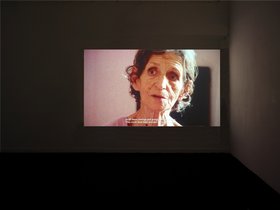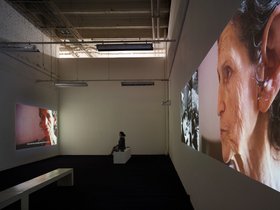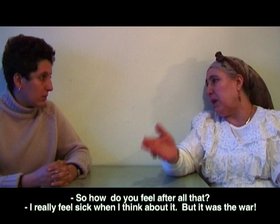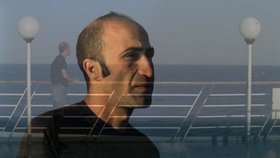Interviews
Zineb Sedira in Conversation
Coline Milliard: You've described yourself as a gardienne de mémoire, a guardian of memory. Do you feel that the preservation and the transmission of memory is one of your roles as an artist?
Zineb Sedira: It's my role as an artist and as a mother. I started thinking about oral history and the passing on of culture and traditions when I had my first daughter in 1991. Being born in France myself, I felt somewhat removed from my parents' culture and I understood that, being born in England, my children would be further removed from their Algerian identity.
Around that time, I was also thinking about the role of women as passeuses de mémoire, particularly in the Middle East and North Africa. When my parents were growing up in French Algeria in the 1930s and 1940s, there were no schools in the countryside – my parents can't read or write – knowledge was transmitted orally. I remember sitting by my mother or my grandmother as they were telling us stories, real or invented. They also told us about Algerian history and how they experienced it. Over the years, I became a good listener and, later, a storyteller.
CM: In your piece Gardiennes d'images (2010) about Safia Kouaci, the widow of photographer Mohamed Kouaci, you capture a moment of transmission from one generation to the next. How did you come across her? Did you know the work of her husband?
ZS: My friend, the artist Amina Menia – who is conducting the interview in the video – had shown me some of Mohamed Kouaci's photographs. He is the only Algerian photographer to have closely followed the Algerian revolution, the independence in 1962 and the aftermath. Going through his pictures, I was astonished by their diversity, their aesthetic qualities, not to mention their sheer quantity. I was also struck by the 'new way' Algerian history was portrayed. The French army and European journalists took most of the images from that period, and these are the representations we are familiar with. Amina is a friend of Kouaci's family. She told me that Safia, who keeps her husband's archive in her flat in Algiers, would be willing to talk about it. So we went to see her.
When I met Safia, I was really touched by her personality, by her knowledge, by her love for her husband and by her involvement in the revolution as a freedom fighter. She is such a fascinating character. I really enjoy listening to the elders, a generation that we don't value enough in Europe. For me, they still hold the key to a certain knowledge and wisdom, especially in places like Algeria where written histories are not so strong. We are used to hearing accounts of the revolution by the former leaders but we rarely hear the voices of regular people like my parents or Safia. The piece is also about ageing and solitude, something we will all face.
CM: The archive is still in her flat. What do you hope for it?
ZS: Amina and I would like to help Safia to find an institution that would scan, preserve and store the archive. The photographs are stored in boxes but they are in Algiers, by the sea, and those negatives and prints are getting damaged by the hour. We also want to give visibility to Kouci's work and one way to do this was the video Gardiennes d'images.
CM: When you showed the piece at the Palais de Tokyo in Paris last December, did any institutions or individuals come forward?
ZS: The exhibition did raise awareness; we had lots of press and many people visited the exhibition. No one has contacted me to meet Safia yet, but it's still early days. We will carry on looking for a solution.
CM: You were born in France and used to go to Algeria on holidays as a child. You stopped going there in the 1990s and went back in the early 2000s, soon buying a flat in Algiers. In a way you consciously re-created a bond with this country. Is that how you see it?
ZS: I have very fond memories of the Algeria that I visited as a child, especially of my grandmother and of her house in the countryside. It was very basic, but I loved it. It felt like home. In France in the 1960s and 1970s, there was a lot of racism against the Algerian community and going on holiday was really refreshing. I didn't go to Algeria much as a teenager, but I went back in 1988, just before the famous riots, to visit my mother, brothers and sisters who had returned to live there. The country had changed a lot and people were struggling. You could feel a nation ready to explode. Then the civil war started in the early 1990s. I was studying art at the time, and had begun to explore issues around my Algerian identity. I really needed to be in Algeria but couldn't go because it was too dangerous. Much of my work from this period is inspired by memories, and discussions I had with my parents when they came to France.
Then in 2002, the Centre Culturel Francais (CCF) invited me to do some research in Algiers. I fell in love with the capital – a city I knew very little, as I come from the east of the country, from a region called Aures – and I started making work about its landscape and architecture. In 2003, it was the 'Year of Algeria' in France and I met many interesting Algerian artists mostly based in Algiers. When I returned the following year, many became friends and I started working with some of them.
CM: How would you describe the art scene in Algiers or in Algeria at large?
ZS: Compared to other North African or Middle Eastern countries, it's not an active art scene. The École des Beaux Arts is very traditional and although there is now a museum of modern and contemporary art (MAMA), private and public spaces are still lacking. What makes it even harder is that Algerians struggle to get visas to travel. The local scene is small – how can you be an artist if you can't see art? And Western curators don't go to Algeria, partly because it is a French-speaking country. Lastly, there's no tourism and the country is often portrayed as a 'dangerous' place. Though there is more bombing in Beirut than in Algiers!
CM: For the last few years you've been thinking about opening a project space in Algiers with your friend and fellow artist Kader Attia. Is it going to happen?
ZS: Since 2005, I've used my flat in Algiers as a platform to invite international artists, curators and academics. I also facilitate meetings between my guests and local artists. This has often led to concrete projects like Joseph McGonagle's exhibition New Cartographies: Algeria-France-UK at Cornerhouse in Manchester or Caroline Hancock's research on the post-colonial affinities existing between Ireland and Algeria. Yourself, you came in 2009. I cannot name everyone here, but this has been very fruitful, and I'll carry on doing it.
In the same spirit, Kader and I felt that it would be important to create art in Algiers; a platform to exhibit international artists in Algiers, with a firm focus on the Maghreb, as we both strongly feel that it tends to be overlooked by the international circuit. We've been trying to set it up for three years now, but Algeria is a difficult country to work in. It's expensive which means that we cannot rent or buy a place and have to rely on public venues, and that involves dealing with officials. The Ministry of Culture is readily spending lots of money on massive temporary exhibitions, but they don't seem to be interested in creating permanent structures. The Pan African Festival (2009) or the FIAC (Festival International d'Art Contemporain), which happens every two years, are important events but they feel more like a facade rather than a long-term investment in the local scene. Kader and I (together with Nadira Laggoune, a local curator and art critic) are working on a project for autumn 2012, so let's wait and see.
CM: 2010 has been a difficult year for you. Your exhibition at the Musée Picasso in Vallauris, France, was closed down because you used the word collaborateur (which in French is associated with the people who sided with the Germans during the Second World War) to translate Harki (which designates the Algerians who sided with the French during the Independence War) in the subtitles of your piece Retelling Histories, my mother told me (2003). And when you agreed to replace collaborateur with Harki, the show remained closed for a long while and the Ministry of Culture had to intervene. You've never experienced these kinds of problems outside France.
ZS: My work is perceived very differently in France, and there is a real divide between the north and the south of the country. The piece censored in Vallauris caused no problem whatsoever when it was shown in Paris. Like most of the south of France, Vallauris is a town where many pieds noirs (ex-French settlers), veterans from the Algerian War and Harkis live. When I first heard that the Harkis were upset because I had used the word collaborateur, my first reaction was 'but they have collaborated!' Then the museum told me that in France, everyone knew the meaning of Harki and so it didn't need to be translated. I agreed and accepted to remove collaborateur.
Later, I realised that the censorship was supported by the French veterans, not just the Harkis as they wanted me to believe. By using collaborateur in my subtitles, I was implying that the French had created collaborators, just like the Germans before them, and they couldn't accept that. How hypocritical and arrogant was this! Up to now, the French government has had real problems recognising the crimes committed during the Algerian War. In 1962, when the French militaries fled Algeria, General de Gaulle's government ordered to abandon the Harkis. Predictably, many of them were killed by the local population.
CM: I have even heard that some Harkis were killed by the French army itself.
ZS: Yes, I know and this is why this censorship is deceitful. They have used the Harkis as a pretext to close my show down. But in the end, this episode was a victory for me. The exhibition re-opened without any problems. So let's hope there won't be any more censorship of this sort in the south of France.
CM: We talked recently about the fact that you are one of the very few, if not the only Algerian artist dealing with the War of Independence War. How do you explain this silence?
ZS: It could be that the Algerians living in Algeria don't deal with the war because they grew up with it. The officials seem unable to celebrate anything else. For the ones living in France, I really don't know. Like the French, they seem to be affected by both amnesia and aphasia! Perhaps they have been conditioned not to reflect on it in the way I do. Let's not forget that I live in the UK and that postcolonial studies are much more important here.
CM: A topic that seems even more taboo is the years of terrorism in Algeria. We were discussing a piece on the subject by Neil Beloufa, Documents are Flat II (2011), and noticing that, except for the painter Ammar Bouras, very few artists, Algerian or otherwise, deal with this period in their work. You told me that you were thinking of doing something about it.
ZS: I didn't live in Algeria during this terrible civil war and for a long time I thought that I had no right to speak about it. But it affected me and it affected my parents who lived there. So now I've started to research a piece on the way intellectuals were systematically targeted by the terrorists. Like Gardiennes d'images, it will be an hommage to the many who lost their lives during this period. I would also like to explore humour. In Algeria, great jokes and funny stories circulate about the civil war.
CM: That's a rather unusual approach.
ZS: I want to be a bit 'lighter' than in some of my previous works. But going back to the eradications of the intelligentsia by the Islamic groups of the time, I have noticed that their 'politics' have succeeded! The intellectuals – the few who are still alive and are not exiled – were not very present during the marches that took place in Algeria recently. They have been 'broken' by ten years of war!
CM: Don't you think they are scared?
ZS: I don't think they are scared but perhaps they believe that Bouteflika's government is not so bad. He got rid of terrorism after all!
CM: With Saphir (2006) you worked with actors for the first (and only) time. And even though there's no dialogue, a strong narrative unfolds in this piece, which has a man and a woman walking in a hotel and around Algiers' port. How would you qualify the role of fiction in your work?
ZS: I don't see Saphir as a fiction. The actors are professional actors but they were chosen for who they were. I wanted an actor who would represent contemporary Algeria, who had had the experience of living in France but had chosen to come back. And I picked this actress because her father was Algerian and Jewish, she is the daughter of a French settler, a pied noir. For the former colonists, the idea of the return is very important. They come back to Algeria to rediscover their roots. I've never asked my actors to act, I asked them to be themselves and react to the context in which I placed them. The piece occupies a space between fiction and documentary.
CM: Since Saphir, the sea has been a reoccurring element in your work. What interests you in this motif?
ZS: I didn't grow up by the sea, I don't know it very well, but I've grown to love it. There is something very meditative yet intense and scary about it. I like this duality, and you can find it in many of my works. Take Saphir for example: there's a woman, a man, the quiet and the noise, the dirt and the clean. We have all experienced the sea and yet it remains a stranger.
CM: You are now working on a project involving lighthouses to be presented at the Folkestone Triennial in June. What was the trigger?
ZS: I remember being offered a book on Algerian lighthouses, which I really liked, and the more I talked with friends in Algiers, the more I felt it was going to be the subject of my next piece. When Andrea Schlieker, the director of the Folkestone Triennial, contacted me, she asked me to propose a project related to the Folkestone seaside and Algeria. It seemed to be the perfect opportunity to work on my lighthouse idea. I went to visit a few of them in Algeria and collected stories. I was taken aback by their locations, their architecture and by the lighthouse keepers' lives. It's such a masculine environment and as a female artist, it was something I wanted to explore. During the shoot, I realised how lucky I was to witness the life of these keepers. Lighthouses in the West have been computerised, unlike in Algeria where the tradition is still alive. People still protect the seashore and save lives. Again I felt that I was the witness of a time that needed to be documented.
Another important element of the work is that the French built these lighthouses as early as 1860. I was interested in the transition before and after independence. I worked with lighthouse keepers' and visitor's logbooks. Through the names, the comments and the handwriting, they are a precious testimony of the colonisation, of the war and of independence. Maybe one day, instead of being a memory keeper, or an image keeper, I could become a lighthouse keeper!
Zineb Sedira's work, Mother, Father and I (2003), is part of the Kamel Lazaar Foundation Collection. View the work here.



















